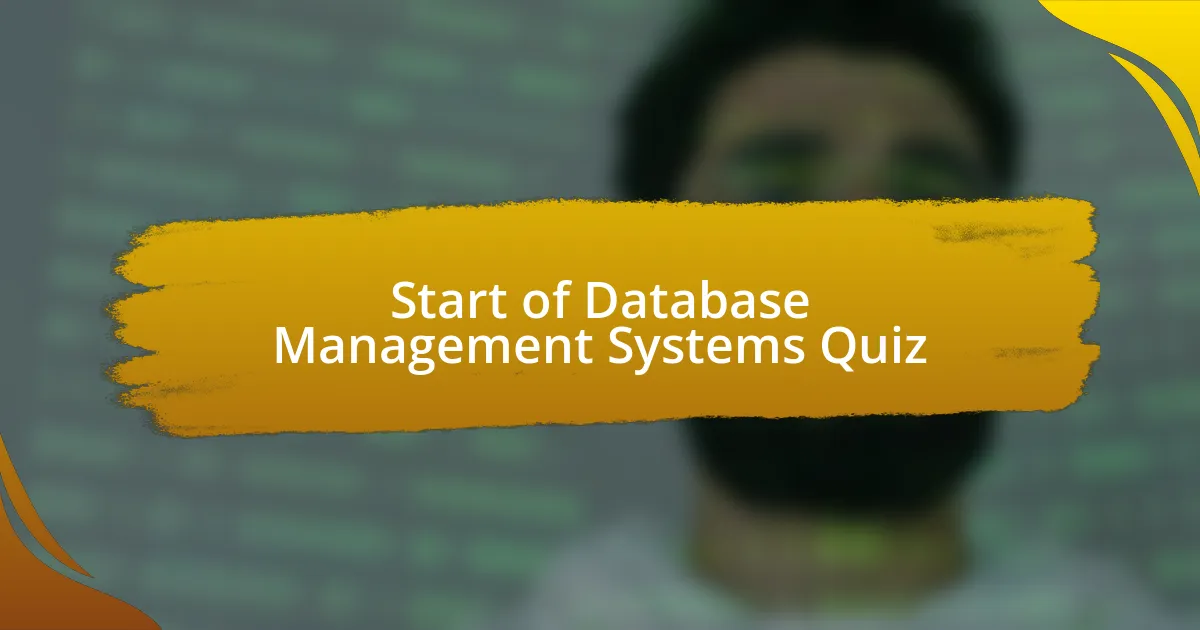
Start of Database Management Systems Quiz
1. What is the full form of DBMS?
- Data Base Management Service
- Data Business Management System
- Digital Backup Management Software
- Database Management System
2. What is a database?
- A type of computer hardware used for data processing.
- A program used solely for creating graphics and images.
- A random assortment of files without structure.
- An organized collection of data or information that can be accessed, updated, and managed.
3. What is DBMS?
- A type of software used for word processing documents.
- A service for streaming media content online.
- A storehouse where authorized users can create, store, modify, or retrieve organized data in tables.
- A system for managing computer hardware functions.
4. Who created the first DBMS?
- Charles Bachman
- Alan Turing
- Ada Lovelace
- Bill Gates
5. Which type of data can be stored in the database?
- Image, text, audio, or video files, etc.
- Plain text only.
- Just spreadsheets.
- Only numerical data.
6. In which format is data stored in the database management system?
- Grid layout
- Table format
- Binary code
- Document structure
7. Which of the following is not a type of database?
- Hyper data
- Key-value data
- Document data
- Relational data
8. What does an RDBMS consist of?
- A collection of tables
- A group of queries
- A set of views
- A collection of indexes
9. The DBMS acts as an interface between which two aspects of an enterprise-class system?
- User interface and network
- Web server and cloud storage
- Database application and the database
- Software application and power supply
10. The ability to query data, as well as insert, delete, and alter tuples, is offered by which SQL clause?
- Data Control Language (DCL)
- Data Manipulation Language (DML)
- Data Definition Language (DDL)
- HAVING clause
11. Which of the following is not a utility of DBMS?
- Managing
- Processing
- Reporting
- Querying
12. What does a foreign key combined with a primary key create?
- Combination
- Overlap
- Relation
- Concatenation
13. Which of the following is the subset of SQL commands used to manipulate Oracle Structures, including tables?
- Data Definition Language (DDL)
- Data Retrieval Language (DRL)
- Data Modification Language (DML)
- Data Access Language (DAL)
14. Which of the following functions construct histograms and use buckets for ranking?
- Data processors
- Data utilities
- Storage engines
- Query analyzers
15. The storage engine is the core component of the DBMS that interacts with which level of the OS?
- Application server
- User interface
- Network layer
- File system
16. What are the common components of a DBMS?
- User interface, application server, programming language, system backup.
- Data analysis, web services, hardware drivers, system registry.
- Data visualization, cloud storage, data encryption, network firewall.
- Storage engine, query language, query processor, optimization engine, metadata catalog, log manager, reporting and monitoring tools, data utilities.
17. Which of the following provides the ability to query information from the database and insert, delete, and modify tuples?
- Data Manipulation Language (DML)
- Hyper Text Markup Language (HTML)
- Standard Query Language (SQL)
- Data Definition Language (DDL)
18. The given query can also be replaced with which SQL command?
- UPDATE
- SELECT
- INSERT
- DELETE
19. Which one of the following given statements possibly contains the error?
- A storehouse where authorized users can create, store, modify, or retrieve organized data in tables.
- To provide users with access to stored data while ensuring data integrity and security.
- Not provided in the sources
- An organized collection of data or information that can be accessed, updated, and managed.
20. Which of the following refers to the number of attributes in a relation?
- Count of relations
- Total tuples
- Index size
- Number of attributes
21. Which of the following is used in application programs to request data from the DBMS?
- Structured Query Language (SQL)
- Query Manipulation System
- Data Access Protocol
- Data Processing Language
22. Which SQL command is used to delete an existing row in a table?
- DROP
- DELETE
- TRUNCATE
- REMOVE
23. Which SQL command is used to save any transaction permanently into the database?
- INSERT
- COMMIT
- SAVE
- UPDATE
24. Which SQL command is used for removing (or deleting) a relation from the SQL database?
- DELETE TABLE
- REMOVE TABLE
- DROP TABLE
- CLEAR TABLE
25. Which SQL command is used to restore the database to its last committed state?
- ROLLBACK
- DELETE
- DROP
- COMMIT
26. The DBMS can be considered as the collection of what that enables us to create and maintain the database?
- Procedures and documents that standardize database management
- Graphs and charts for data visualization
- Scripts and codes for programming languages
- Tables and columns for organizing information
27. The term `DFD` stands for?
- Database Format Description
- Data Field Definition
- Data Function Design
- Data Flow Diagram
28. Which of the following refers to the collection of information stored in a database at a specific time?
- Datafile
- Index
- Recordset
- Snapshot
29. The term `SQL` stands for?
- Standard Query Language
- Sequential Query Language
- Structured Query Language
- Simple Query Language
30. What are the fundamental concepts and features of a DBMS?
- Access control, network management, data compression, schema evolution.
- Data formats, storage types, web integration, application servers.
- Data models, query languages, file organization and indexing, normalization, candidate keys, and key fields.
- File types, user authentication, programming languages, graphical interfaces.

Quiz Successfully Completed!
Congratulations on completing the quiz on Database Management Systems! You’ve engaged with key concepts and essential practices that form the foundation of efficient data management. Whether it was understanding normalization, grasping transaction management, or exploring database models, each question has likely deepened your insight into how databases operate.
This learning experience emphasizes the importance of databases in our digital world. You’ve gained knowledge about how they store and manage data, support decision-making, and enable applications to function smoothly. These skills are vital in various fields, from business to technology. Each lesson learned here will serve you well in your ongoing journey with database management.
To further enhance your understanding, we invite you to explore the next section on this page, which provides in-depth information about Database Management Systems. This resource is designed to expand your knowledge and help you apply what you’ve learned. Dive in and continue your learning journey today!

Database Management Systems
Introduction to Database Management Systems
Database Management Systems (DBMS) are software applications that interact with users, other applications, and the database itself to capture and analyze data. They enable the creation, retrieval, update, and deletion of data in a systematic manner. DBMSs help organize data in a structured format, ensuring data integrity and security. They provide a systematic way to manage large volumes of data, enabling efficient communication between users and the database.
Types of Database Management Systems
There are several types of DBMS, including relational, NoSQL, hierarchical, and object-oriented. Relational DBMS (RDBMS) store data in tables and use Structured Query Language (SQL) for querying. NoSQL databases cater to unstructured data and offer flexible schemas, which suit big data applications. Hierarchical DBMS organize data in a tree-like structure, while object-oriented DBMS combine object-oriented programming with database capabilities to facilitate complex data structures.
Key Features of Database Management Systems
Essential features of DBMS include data definition, data manipulation, data security, and data integrity. Data definition involves schema creation, enabling users to define the structure of the data. Data manipulation allows users to perform operations such as inserting, updating, and deleting data. Security features protect data from unauthorized access, while integrity checks ensure that the data remains accurate and reliable throughout its lifecycle.
Advantages of Using Database Management Systems
DBMS offers numerous advantages, including improved data sharing, enhanced data security, and better data integration. They allow multiple users to access the same data simultaneously without conflicts. Security measures within DBMSs safeguard sensitive information. Additionally, they enable seamless integration of data across different applications, providing a unified view of information for end users.
Database Management Systems and Data Modeling
Data modeling in DBMS refers to the process of creating a conceptual representation of data and its relationships. This involves defining entities, attributes, and their interconnections. Effective data modeling is crucial for ensuring optimal database design. Proper modeling influences data retrieval efficiency and supports scalability, ultimately impacting application performance and user satisfaction.
What is a Database Management System?
A Database Management System (DBMS) is software that enables users to create, manage, and manipulate databases. It serves as an interface between users and the database, allowing for efficient data storage, retrieval, and organization. Common examples include MySQL, Oracle, and Microsoft SQL Server. According to the market research firm Gartner, the DBMS market is projected to reach $107 billion by 2024, highlighting its crucial role in data management.
How does a Database Management System work?
A DBMS operates by providing a systematic way to create, retrieve, update, and manage data. It uses structured query language (SQL) to facilitate this interaction. The system organizes data into tables, reducing redundancy and ensuring data integrity. For instance, most relational database systems support ACID properties (Atomicity, Consistency, Isolation, Durability), which enhance reliability in transactions.
Where are Database Management Systems commonly used?
DBMS are widely used in various sectors, including finance, healthcare, education, and e-commerce. They support applications like online banking systems, patient record management, and inventory control. In fact, a 2021 report from the International Data Corporation stated that over 60% of businesses rely on DBMS to handle large volumes of data efficiently.
When was the first Database Management System developed?
The first DBMS, called “IMS” (Information Management System), was developed by IBM in 1966. IMS was designed for hierarchical databases and primarily used for managing data in large-scale applications. This marked the beginning of organized data management systems, later evolving into relational databases in the 1970s.
Who benefits from using Database Management Systems?
Businesses and organizations of all sizes benefit from using DBMS. They enable data analysts, developers, and administrators to efficiently manage data. Enhanced data accessibility allows decision-makers to analyze trends and make informed decisions. According to a report by Demand Metric, organizations that invest in DBMS see an average of 20% improvement in operational efficiency.
















